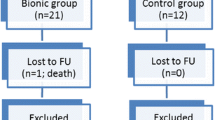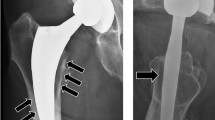Abstract
In osteoporotic patients cemented stems are usually used to achieve a good primary stability. However, when patients are obese or active the long-term survival of cemented prostheses is questioned. In these patients, a partially-cemented stem with a hybrid fixation could be advantageous. A hybrid stem was retrospectively evaluated at a minimum follow-up of 60 months (mean, 75 months) in 58 osteoporotic women: seventeen with a body mass index (BMI) >30 (obese), 41 with a BMI between 25 and 29.9 (overweight), and an UCLA score for activity level >6. At the latest follow up, the Harris hip score improved from 33.5 points preoperatively to 81.6 points, and the WOMAC score improved significantly. Three stems (4.9%) had an asymptomatic subsidence of less than 2.5 mm; no stem was revised. These results support the use of partially-cemented stems in heavy or active osteoporotic women.
Résumé
Chez les patients présentant une ostéoporose une pièce fémorale cimentée est habituellement utilisée de façon à avoir une bonne stabilité. Cependant chez certains patients obèses et très actifs la courbe de survie peut, dans ce cas, être altérée. Ces patients ont eu la possibilité d’être opérés avec une prothèse partiellement cimentée, cette fixation hybride pouvant être avantageuse. Matériel et méthode: cette prothèse fémorale hybride a été évaluée de façon rétrospective avec un minimum de suivi de 60 mois (en moyenne 75 mois) chez 58 patients ostéoporotiques,17 femmes présentant un BMI > 30 (obèses), 41 avec un BMI entre 25 et 29,9 (surpoids) et un score UCLA supérieur à 6. Résultats: au dernier suivi le score de Harris a montré une amélioration de 33,5 points en préopératoire à 81,6 points, le score de Womac s’est également amélioré de façon significative. Trois pièces fémorales ont présenté une migration (4,9%) de moins de 2,5 millimètres, aucune révision fémorale n’a été réalisée. En conclusion, ces résultats permettent de penser qu’une prothèse partiellement cimentée hybride est indiquée chez ces patients obèses actifs et présentant une ostéoporose notamment chez la femme.


Similar content being viewed by others
References
Bachus KN, Bloebaum RD, Jones RE (1999) Comparative micromotion of fully and proximally cemented femoral stems. Clin Orthop Relat Res 248–257
Baleani M, Cristofolini L, Toni A (2000) Initial stability of a new hybrid fixation hip stem: experimental measurement of implant-bone micromotion under torsional load in comparison with cemented and cementless stems. J Biomed Mater Res 50:605–615
Bellamy N, Buchanan WW, Goldsmith CH, Campbell J, Stitt LW (1988) Validation study of WOMAC: a health status instrument for measuring clinically important patient relevant outcomes to antirheumatic drug therapy in patients with osteoarthritis of the hip or knee. J Rheumatol 15:1833–1840
Brooker AF, Bowerman JW, Robinson RA, Riley LH Jr (1973) Ectopic ossification following total hip replacement. Incidence and a method of classification. J Bone Joint Surg Am 55:1629–1632
Cristofolini L, Erani P, Teutonico AS, Traina F, Viceconti M, Toni A (2007) Partially cemented AncaDualFit hip stems do not fail in simulated active patients. Clin Biomech 22:191–202
Dickob M, Martini T (1996) The cementless PM hip arthroplasty. Four-to-seven-year results. J Bone Joint Surg Br 78:195–199
Dorr LD, Arnala I, Faugere MC, Malluche HH (1990) Five-year postoperative results of cemented femoral arthroplasty in patients with systemic bone disease. Clin Orthop Relat Res:114–121
Einsiedel T, Gebhard F, Bregolato I, Hiemeier A, Kinzl L, Schultheiss M (2008) Proximal cement fixation in total hip arthroplasty first results with a new stem design. Int Orthop 32(3):295–306
Engh CA, Massin P, Suthers KE (1990) Roentgenographic assessment of the biologic fixation of porous-surfaced femoral components. Clin Orthop Relat Res:107–128
Eskelinen A, Remes V, Helenius I, Pulkkinen P, Nevalainen J, Paavolainen P (2005) Total hip arthroplasty for primary osteoarthrosis in younger patients in the Finnish arthroplasty register. 4,661 primary replacements followed for 0–22 years. Acta Orthop 76:28–41
Harris WH (1969) Traumatic arthritis of the hip after dislocation and acetabular fractures: treatment by mold arthroplasty. An end-result study using a new method of result evaluation. J Bone Joint Surg Am 51:737–755
Janssen I, Katzmarzyk PT, Boyce WF, King MA, Pickett W (2004) Overweight and obesity in Canadian adolescents and their associations with dietary habits and physical activity patterns. J Adolesc Health 35:360–367
Jeffers JR, Browne M, Lennon AB, Prendergast PJ, Taylor M (2007) Cement mantle fatigue failure in total hip replacement: experimental and computational testing. J Biomech 40:1525–1533
Jingushi S, Noguchi Y, Shuto T, Nakashima T, Iwamoto Y (2000) A device for removal of femoral distal cement plug during hip revision arthroplasty: a high-powered drill equipped with a centralizer. J Arthroplasty 15:231–233
Jones RE, Willie BM, Hayes H, Bloebaum RD (2005) Analysis of 16 retrieved proximally cemented femoral stems. J Arthroplasty 20:84–93
Kester MA (1993) Design and analysis of a proximally cemented hip stem. 19th annual meeting of the Society for Biomaterials, Birmingham, AL, USA
Lou XF, Li YH, Lin XJ (2007) Effect of proximal femoral osteoporosis on cementless hip arthroplasty: a short-term clinical analysis. J Zhejiang Univ Sci B 8:76–80
Makinen TJ, Alm JJ, Laine H, Svedstrom E, Aro HT (2007) The incidence of osteopenia and osteoporosis in women with hip osteoarthritis scheduled for cementless total joint replacement. Bone 40:1041–1047
Mohler CG, Callaghan JJ, Collis DK, Johnston RC (1995) Early loosening of the femoral component at the cement-prosthesis interface after total hip replacement. J Bone Joint Surg Am 77:1315–1322
Monti L, Cristofolini L, Viceconti M (2001) Interface biomechanics of the Anca Dual fit hip stem: an in vitro experimental study. Proc Inst Mech Eng [H] 215:555–564
Roth A, Winzer T, Babisch J, Fuhrmann R, Sander K, Venbrocks R (2005) Radiological changes around the stem after cementless hip implantation in case of the anatomic medullary locking hip system – five years results. Acta Chir Orthop Traumatol Cech 72:42–46
Verdonschot N (2005) Philosophies of stem designs in cemented total hip replacement. Orthopedics 28:833–840
Viceconti M, Cristofolini L, Baleani M, Toni A (2001) Pre-clinical validation of a new partially cemented femoral prosthesis by synergetic use of numerical and experimental methods. J Biomech 34:723–731
Vora A, Kudrna JC, Harder VS, Mazahery B (2003) Early failure of a proximally cemented, distally uncemented total hip arthroplasty. J Arthroplasty 18:889–896
Zahiri CA, Schmalzried TP, Szuszczewicz ES, Amstutz HC (1998) Assessing activity in joint replacement patients. J Arthroplasty 13:890–895
Author information
Authors and Affiliations
Corresponding author
Rights and permissions
About this article
Cite this article
Traina, F., Tassinari, E., Pilla, F. et al. Outcome of hybrid stem fixation in osteoporotic female patients. A minimum five-year follow-up study. International Orthopaedics (SICOT) 33, 1489–1494 (2009). https://doi.org/10.1007/s00264-008-0645-5
Received:
Revised:
Accepted:
Published:
Issue Date:
DOI: https://doi.org/10.1007/s00264-008-0645-5




